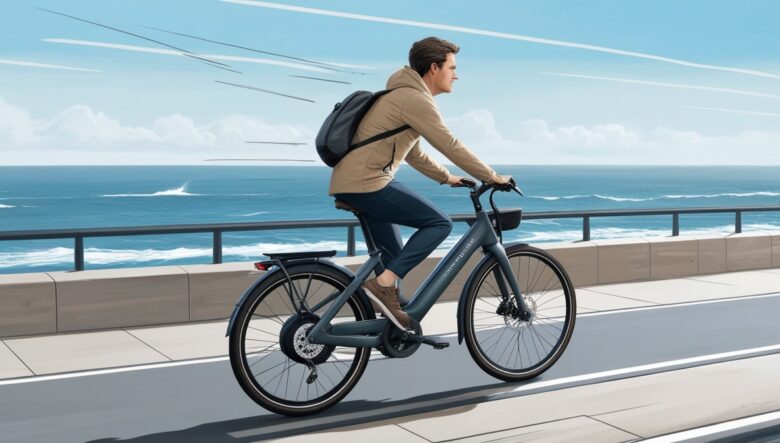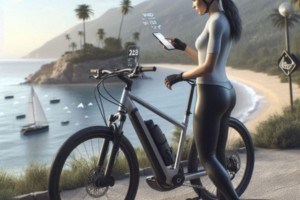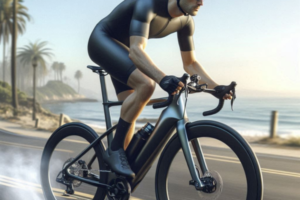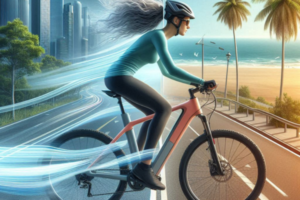To optimize the aerodynamics of your electric bicycle in coastal environments, it’s essential to understand how sea winds, humidity, and air salinity affect your ride. These environmental factors increase wind resistance, reduce battery performance, and accelerate the deterioration of your bike components. Riders living near the ocean must adapt their equipment and habits to maintain speed, comfort, and durability. 🌊🚲
Whether you’re a daily commuter or a weekend explorer, enhancing your e-bike’s aerodynamic performance helps conserve energy and improve control on open, windy routes. This article is your complete guide to navigating these challenges—covering riding posture, gear, maintenance strategies, and design tips tailored specifically for coastal urban cyclists.
Why does it matter? Coastal cities expose you to stronger crosswinds, fluctuating air pressure, and salt-heavy humidity. These conditions increase drag and friction, forcing your bike’s motor to work harder. If you’re not paying attention to the aerodynamics of your e-bike, you’ll notice shorter battery range, less stability, and a much harder ride.
Optimizing the aerodynamics of your electric bicycle in coastal environments isn’t just a performance hack—it’s a necessity for long-term efficiency and safety.
In the next sections, we’ll show you how to fine-tune your posture, pick the right accessories, protect your bike from corrosion, and keep it aerodynamic throughout the year.
💡 Quick Tip: If you live near the beach, wipe down your e-bike after every ride. Salt crystals can roughen your bike’s frame, increasing drag and reducing component life.
Now, let’s explore exactly how coastal weather impacts the aerodynamic performance of your e-bike—and what you can do about it.
If you want to optimize the aerodynamics of your electric bicycle in coastal environments, you must first understand what you’re up against. Coastal cities are beautiful, but they present a hostile setting for e-bike riders. The constant presence of strong winds, salt-laden air, and fluctuating humidity levels all combine to create high-drag conditions that sap battery power and reduce ride comfort. 🌫️🌬️
🌪️ Wind: Your Constant Coastal Companion
Wind resistance is a challenge everywhere, but it’s particularly aggressive in coastal areas. Ocean breezes often blow perpendicular to the coast, creating unexpected crosswinds. Headwinds are common along open beachside roads, making it difficult to maintain speed—even with motor assistance. These factors increase drag, which directly affects energy efficiency and rider control.
Drag grows exponentially with speed, so even moderate wind can lead to a dramatic increase in energy expenditure. For e-bike riders, this means faster battery drain, more frequent recharges, and higher stress on the motor system.
💧 Humidity and Salt: Hidden Aerodynamic Saboteurs
Humidity makes coastal air heavier with moisture, and that moisture is often infused with microscopic salt particles. These particles attach themselves to your bike frame and components, especially in areas with turbulent airflow. Over time, this creates microscopic roughness that disrupts smooth air flow and increases resistance. It also adds weight and accelerates corrosion.
Salt buildup also affects rider comfort. It can fog up glasses, reduce helmet visibility, and increase the risk of unstable riding posture—all of which interfere with maintaining an aerodynamic profile on your e-bike.
🏖️ Terrain and Urban Layout in Coastal Cities
Unlike dense inland urban environments with buildings that block and redirect airflow, coastal areas often have long, exposed stretches of road with no wind protection. Bridges, seawalls, and beachfront bike paths leave riders fully exposed to wind gusts. This directly impacts how well you can optimize the aerodynamics of your electric bicycle.
🔍 Main Aerodynamic Problems Coastal Riders Face:
- Sudden wind changes on open beach paths
- Moisture buildup increasing drag and weight
- Corrosion of smooth surfaces that should reduce friction
- Unstable posture due to unexpected gusts
- Battery strain from high wind resistance
🔍 Visual Insight: Think of your bike and body like a sailboat in a storm. In a coastal city, you’re constantly facing invisible forces pushing against your progress. Without the right aerodynamic setup, each pedal stroke and motor burst is fighting unnecessary resistance.
So, how do we fight back? The answer lies in proactive design, smarter habits, and strategic upgrades. In the next section, we’ll explore the practical steps you can take to optimize aerodynamics of your electric bicycle in coastal cities using posture, accessories, and intelligent gear.
To truly optimize the aerodynamics of your electric bicycle in coastal environments, it’s essential to go beyond awareness and put strategy into action. The right posture, combined with specialized equipment, can significantly reduce drag, improve speed, and preserve battery life—especially when riding through high-humidity, high-wind zones near the sea. This section breaks down the most effective ways to enhance your aerodynamic profile using smart techniques and practical upgrades. 🧠⚙️
🧘♂️ Posture: The First Step Toward Efficiency
How you position your body on your e-bike has a direct impact on how wind flows around you. While electric bikes often encourage a relaxed, upright posture, that comfort comes at a cost—namely, increased air resistance. By making small but targeted adjustments, you can dramatically reduce your frontal area and minimize drag, especially in exposed coastal areas where the wind is relentless.
✔️ Posture Tips for Aerodynamic Riding:
- Lean forward slightly while keeping your spine neutral.
- Lower your shoulders and bend your elbows inward.
- Keep your arms close to your body to minimize side exposure.
- Position your head down slightly while maintaining road awareness.
- Avoid bulky backpacks that create drag behind you.
🌟 Coastal Rider Tip: A minor seat angle change or a shorter handlebar stem can naturally promote a more aerodynamic posture without compromising comfort—perfect for windy beachside routes.
🎒 Gear That Works With the Wind, Not Against It
The next step to optimize aerodynamics of your electric bicycle in coastal conditions is choosing gear that cuts through wind instead of catching it. Coastal riders should avoid baggy clothes and unnecessary accessories. Instead, opt for aerodynamic helmets, close-fitting apparel, and streamlined panniers that taper at the rear.
Recommended Aerodynamic Add-ons:
- Aero helmets – Reduce turbulence over your head and neck.
- Low-drag panniers – Designed to minimize wake behind the rider.
- Spoke covers – Useful in coastal crosswinds to prevent swirling air.
- Handlebar fairings – Decrease frontal resistance significantly.
- Compression cycling apparel – Cuts drag and dries quickly in humid air.
🚲 Frame Design and Material Considerations
Your e-bike’s frame also plays a major role in aerodynamic performance. While carbon fiber frames are ideal due to their sleek profile and corrosion resistance, they may not fit every budget. Many coastal commuters achieve great results with aluminum frames that have aerodynamic shaping and weather-resistant coatings.
Comparative Table: Frame Options for Coastal Aerodynamics
| Material | Aerodynamic Potential | Resistance to Salt |
|---|---|---|
| Carbon Fiber | Excellent | Excellent |
| Aluminum | Good | Good (with coating) |
| Steel | Fair | Poor |
Every small adjustment adds up. From gear to body positioning to frame material, optimizing the aerodynamics of your electric bicycle in coastal environments allows you to ride longer, faster, and safer.
Next, let’s explore how to maintain your e-bike so that it stays aerodynamic even as salt, moisture, and wear try to slow you down. 🔧💧
Maintaining your e-bike isn’t just about keeping it clean—it’s about protecting its aerodynamic performance. If you want to optimize the aerodynamics of your electric bicycle in coastal environments, you must actively fight the effects of salt, moisture, and air corrosion. Over time, these elements degrade the bike’s surfaces, create drag, and interfere with components that should be working together seamlessly. 🧽🌊
🌬️ Salt and Moisture: Aerodynamic Enemies
Coastal air is full of microscopic salt particles. When these settle on your bike, they attract moisture, creating a sticky layer that roughens aerodynamic surfaces. This can interfere with air flow across the frame and components—especially if you use fairings or panniers designed for wind-cutting performance. Worse, over time this buildup causes corrosion, which increases drag even more.
Maintaining a smooth, clean surface on your e-bike is key to maintaining efficiency. Dirt and salt accumulation act like mini speed bumps for airflow, creating turbulence where there should be smooth, laminar movement.
🧪 Weekly Maintenance to Protect Aerodynamics
A consistent cleaning and inspection routine will help you optimize the aerodynamics of your electric bicycle in coastal cities by reducing drag and keeping parts running smoothly.
🔧 Weekly E-Bike Maintenance Checklist:
- Rinse frame and wheels with fresh water to remove salt buildup
- Use a microfiber cloth to gently wipe aerodynamic surfaces
- Apply ceramic or silicone spray to smooth metal and plastic parts
- Re-lubricate chain with waterproof e-bike lubricant
- Inspect panniers and fenders for cracks or warping
⚠️ Aerodynamic Insight: Even small patches of rust or debris on your frame can change how air flows around your bike. Over time, this causes performance loss and forces the motor to work harder, reducing battery efficiency.
🛡️ Protective Products That Preserve Efficiency
There are many affordable solutions that help protect your bike from the corrosive coastal environment while maintaining its aerodynamic properties. Below is a list of recommended products:
| Product | Purpose | Where to Apply |
|---|---|---|
| Ceramic Coating Spray | Smooth finish, salt protection | Frame, panniers, fenders |
| Waterproof Lubricant | Maintains smooth drivetrain | Chain, derailleur, axles |
| Anti-Corrosion Spray | Stops rust before it starts | Bolts, joints, handlebar stem |
With just a few minutes each week, you’ll maintain a smooth, drag-resistant surface and protect your components from long-term wear—key elements if your goal is to optimize aerodynamics of your electric bicycle in coastal conditions.
In the final section, we’ll wrap everything up with clear takeaways, FAQs, and a community call to action for coastal e-bike riders just like you. 🏁🌟
Whether you’re commuting along palm-lined avenues or cruising beside the sea at sunset, the decision to optimize the aerodynamics of your electric bicycle in coastal environments can transform your experience. From posture to protection, every detail matters. In this article, we’ve explored how wind, salt, and humidity impact your e-bike and how small changes can make a big difference in speed, energy savings, and long-term durability. 🌴💨
🔁 Recap: Coastal Aerodynamic Optimization
- Adopt a forward-leaning posture to reduce wind resistance.
- Wear aerodynamic clothing and choose tapered panniers or fenders.
- Clean and inspect your bike weekly to prevent salt buildup and corrosion.
- Use ceramic coatings and anti-corrosion sprays to keep surfaces smooth.
- Store your e-bike in dry, shaded areas to preserve aerodynamic materials.
These steps are practical, low-cost, and highly effective in extending the performance and lifespan of your electric bike. They also contribute to a smoother, quieter ride—and in a coastal city, that can mean the difference between a frustrating commute and a joyful journey. 🌞⚡
🌿 Inspiring Thought: “Smooth roads don’t make skillful riders—strong winds do. And every breeze you overcome is a step closer to mastery.”
❓ Frequently Asked Questions (FAQs)
1. How often should I clean my e-bike in a coastal city?
At least once per week. If you’re riding daily near the ocean, a light rinse after each ride can prevent salt buildup that increases aerodynamic drag.
2. Can I still optimize aerodynamics if I have a step-through frame?
Yes. While traditional diamond frames offer better airflow, you can still optimize posture, use fairings, and install streamlined accessories to reduce drag.
3. What’s the most affordable aerodynamic upgrade?
Aero helmets and tight-fit clothing offer major gains at low cost. They instantly reduce the surface area exposed to wind.
4. Does posture really make a difference?
Absolutely. Posture is one of the biggest contributors to wind resistance. Small shifts in body position can dramatically reduce drag and energy use.
5. How do I protect my components from salt without damaging performance?
Use non-greasy, waterproof products like ceramic coatings and e-bike-safe lubricants. These help you optimize the aerodynamics of your electric bicycle in coastal cities without attracting dirt or interfering with motion.
🌐 Join the Coastal E-Bike Community
Thousands of riders around the world are adapting their bikes to the challenges of coastal life. If you’ve discovered a great product, built a custom setup, or learned how to fight the sea breeze like a pro, we’d love to hear from you!
💬 Leave a comment below or subscribe to our newsletter for monthly updates on aerodynamic gear, coastal riding tips, and expert advice.
📣 Community Call: Share your best aerodynamic upgrade or maintenance trick. Let’s build a smarter, more efficient community of coastal riders—one gust at a time.
Thank you for joining us. Now that you know how to optimize the aerodynamics of your electric bicycle in coastal environments, the next ride is yours to conquer—with less drag, more distance, and total control. 🌬️🚴♂️



